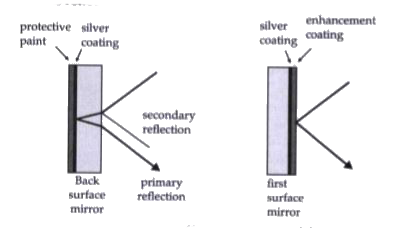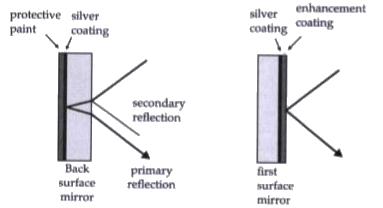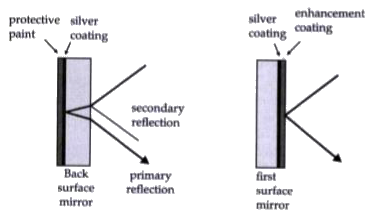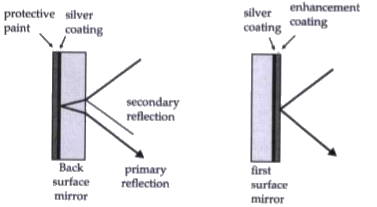Using the Fresnel equations, find:
(a) the reflection coefficient of natural light falling normally on the surface of glass,
(b) the relative loss of luminous flux due to reflections of a paraxial ray of natural light passing through an aligned aoptical system comprising five glass lenses (secondary reflections o flight are to be neglected).
We decompose the natural light into two components with intensity where has its electirc vector oscillating parallel to the plane of incidence and has the same to it.
By Frensel's equations for normal incidence
similarly
Thus
(b) The reflected light at the first surface has the intensity
Then the transmitted light has the intensity
At the second surface where light emerges form glass inot air, the reflection coefficient is again because is invariant under the subsitution .
Thus and .
For lenses the loss in luminous flux is then
for

Topper's Solved these Questions
- BOOK - IE IRODOV, LA SENA & SS KROTOVCHAPTER - OPTICSEXERCISE - Dispersion And Absorption Of Light24videos
OPTICS
- BOOK - IE IRODOV, LA SENA & SS KROTOVCHAPTER - OPTICSEXERCISE - Optics Of Moving Sources22videos
OPTICS
- BOOK - IE IRODOV, LA SENA & SS KROTOVCHAPTER - OPTICSEXERCISE - Diffraction Of Light60videos
OPTICS
- BOOK - IE IRODOV, LA SENA & SS KROTOVCHAPTER - MECHANICSEXERCISE - Mechanics Problems92videos
MECHANICS
- BOOK - IE IRODOV, LA SENA & SS KROTOVCHAPTER - OSCILLATIONS AND WAVESEXERCISE - Electromagnetic Waves, Radiation36videos
OSCILLATIONS AND WAVES
Similar Questions
A beam of natural light falls on the surface of glass at an angle of 45∘. Using the Fresnel equations, find the degree of polarization of
(a) reflected light,
(b) refracted light.View SolutionNatural light falls at the Brewster angle on the surfcae of glass. Using the Fresnel equations, find
(a) the reflection coefficient,
(b) the degree of polarization of refracted light.View Solution
Knowledge Check
- Question 1 - Select One
First Surface Mirror:
Normally we use back surface mirrors. These are considered low precision mirrors because they actually have two reflecting surfaces. The first reflecting surface is the initial surface on the pane of glass where a small percentage of light is reflected off the surface. The second reflecting surface is the aluminium coating where a high percentage of light is reflected off the surface.

This dual reflection effect of a low precision mirror causes a loss of contrast and image distortion that is undesirable in high precision applications like rear projection systems, scanners and reflecting telescopes. In these cases good image quality is highly preferred, and this is where a front surface mirror is desired for clarity and single image reflection. First surface mirrors are quite common in professional optics. However, compared with back surface mirrors, they have the important disadvantage of being substantially more sensitive. The front surface may be touched, and a metal coating on the front surface is substantially more sensitive than a bare glass surface. For example, fingerprints can easily cause oxidation of the metal. Also, moisture or aggressive gases may cause oxidation of the mirror coating.
Light incident on back surface mirror suffers:Atwo reflections.Bone reflectionCtwo reflections and two refractions.Done refraction and one reflection. - Question 2 - Select One
First Surface Mirror:
Normally we use back surface mirrors. These are considered low precision mirrors because they actually have two reflecting surfaces. The first reflecting surface is the initial surface on the pane of glass where a small percentage of light is reflected off the surface. The second reflecting surface is the aluminium coating where a high percentage of light is reflected off the surface.

This dual reflection effect of a low precision mirror causes a loss of contrast and image distortion that is undesirable in high precision applications like rear projection systems, scanners and reflecting telescopes. In these cases good image quality is highly preferred, and this is where a front surface mirror is desired for clarity and single image reflection. First surface mirrors are quite common in professional optics. However, compared with back surface mirrors, they have the important disadvantage of being substantially more sensitive. The front surface may be touched, and a metal coating on the front surface is substantially more sensitive than a bare glass surface. For example, fingerprints can easily cause oxidation of the metal. Also, moisture or aggressive gases may cause oxidation of the mirror coating.
The front surface coating:Ais susceptible to moisture.Bis not so sensitive.Cis worse than back surface coating.Dcannot prevent dual reflection. - Question 3 - Select One
First Surface Mirror:
Normally we use back surface mirrors. These are considered low precision mirrors because they actually have two reflecting surfaces. The first reflecting surface is the initial surface on the pane of glass where a small percentage of light is reflected off the surface. The second reflecting surface is the aluminium coating where a high percentage of light is reflected off the surface.

This dual reflection effect of a low precision mirror causes a loss of contrast and image distortion that is undesirable in high precision applications like rear projection systems, scanners and reflecting telescopes. In these cases good image quality is highly preferred, and this is where a front surface mirror is desired for clarity and single image reflection. First surface mirrors are quite common in professional optics. However, compared with back surface mirrors, they have the important disadvantage of being substantially more sensitive. The front surface may be touched, and a metal coating on the front surface is substantially more sensitive than a bare glass surface. For example, fingerprints can easily cause oxidation of the metal. Also, moisture or aggressive gases may cause oxidation of the mirror coating.
Precision of back surface mirrors is:Ahigh.Blow.Cdepends on intensity of light.Dsimilar to first surface mirror.
A plane beam of natural light with intensity I0 falls on the surface of water at the Brewster angle. A fraction ρ=0.039 of luminous flux is reflected. Find the intensity of the refracted beam.
View SolutionA beam of monochromatic light passes through a pile of N=5 identical plane-parallel glass plates each of thickness l=0.50cm. The coefficient of reflection at each surface of the plates is ρ=0.050. The ratio of the intensity of light transmitted through the pile of plates to the intensity of incident light is τ=0.55 Neglecting the secondary reflections of light, find the absorption coefficient of the given glass.
View SolutionA beam of monichromatic light falls normally on the surfcae of a plane-parallel plate of thickness l. The absorption coefficient of the substance the plate is made of varies linearly along the normal to its surfcae from x1 to x2. The coefficient of reflection at each surface of the plate is equal to ρ. Neglecting the secondary reflections, find the transmission coefficient of such a plate.
View SolutionA point source of monochromatic light emitting a lumninous flux Φ is positioned at the cnetre of a spherical layer of substance. The inside radius of the layer is a, the outside one is b. The coefficient of linear absorption of the substance is equal to x, the reflection coefficient of the surfcaes is equal to ρ. Neglecting the secondary reflections, find the intensity of light taht passes through that layer.
View SolutionFirst Surface Mirror:
Normally we use back surface mirrors. These are considered low precision mirrors because they actually have two reflecting surfaces. The first reflecting surface is the initial surface on the pane of glass where a small percentage of light is reflected off the surface. The second reflecting surface is the aluminium coating where a high percentage of light is reflected off the surface.

This dual reflection effect of a low precision mirror causes a loss of contrast and image distortion that is undesirable in high precision applications like rear projection systems, scanners and reflecting telescopes. In these cases good image quality is highly preferred, and this is where a front surface mirror is desired for clarity and single image reflection. First surface mirrors are quite common in professional optics. However, compared with back surface mirrors, they have the important disadvantage of being substantially more sensitive. The front surface may be touched, and a metal coating on the front surface is substantially more sensitive than a bare glass surface. For example, fingerprints can easily cause oxidation of the metal. Also, moisture or aggressive gases may cause oxidation of the mirror coating.
In professional optics:View Solution

